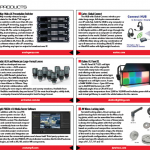
The world is becoming more energy-conscious by the day. For large event facilities, energy costs are a major line item of the budget as organizations add to their load with audio, video, and lighting (AVL) systems. The good news is that some of these operating and associated costs can be reduced or outright avoided with the right power control solution.
There are certainly several different solutions to reduce power consumption. Turn off the lights and other equipment and replace incandescent lighting with LED fixtures. Upgrade lighting systems and “turn off” the AVL Systems through the use of “standby” or vampire power modes and dimming lighting fixtures to zero.
Hidden Costs
However, your utility costs tell a much different—and a shockingly costlier—story. That’s because all that AV equipment and those new LED lighting fixtures are not actually turning off when powered down into standby mode or dimming to zero, although they appear to be off. Need proof? Touch the heat sink on the back of a performance spotlight after it’s long been “turned off”. It will feel hot to the touch because the power was never truly turned off—drivers, processors, motherboards, and other internal components for the lighting and AV gear are still energized and awaiting the next command. Because the end-loads are still energized, they’re generating heat, which can cost in many ways. It can add to the bottom line of a utility bill, up the HVAC load, and naturally degrade the electrical components of AVL gear, internally and significantly shortening the fixtures overall lifespan leading to an increase in maintenance costs and earlier replacement cycles than necessary.
Energy costs and associated operating or maintenance costs related to AVL equipment weren’t always such an expensive line item on the budget. It’s only in the last decade that venues of all sizes have invested more capital into AVL gear. Rather than a simple loudspeaker system and two or three wired microphones, it’s not uncommon for facilities to simply upgrade their entire AVL outfit that may include wireless microphones, powered PA systems, video walls, projectors, mixing boards, and LED lighting. This increase in energy consumption as more circuits are added — and then left on in a standby power mode inflates costs exponentially. For example, a facility that designates 12 circuits for audio, eight circuits for a video wall, and 20 circuits for performance LED lighting fixtures, control, and processors is leaving 40 circuits powered at a full electrical draw or a slightly lower standby draw nearly 100% of the time.
In Kansas City, Missouri, electricity costs 10.75 cents/kWh, with a hypothetical 20W/hour average standby draw per AVL fixture. If your systems are “in use” an average of 7 hours per week energy cost savings per year can be calculated using a simple equation:
Energy Cost Savings Per Year = (Standby consumption) x (Standby Hours/Week) x (52 week) x (kWh cost) / (1,000) For example: (20 x 200) x (168-7 hrs.) x (52) x ($0.10751) / 1,000
The approximate energy cost savings per year comes about to $3,555.57 thanks to being able to completely power down an AVL system. In some places like Chicago, where the average cost of electricity per kilowatt hour is 4.03 cents, facilities will save less. But in Hawaii, electricity can cost upwards of seven times as much at 30.6 cents/kWh, allowing for greater savings.
The Price of Keeping Cool
Another factor contributing to higher utility costs is removing heat. Even standby or vampire power draws generate heat, and with more AVL equipment, the temperature of a facility will be higher. This in turn will tell the cooling system to run more frequently increasing your energy usage. You can put a price on that heat as well by simply calculating the BTUs per a watt: 1 watt = 3.412 BTU/hr (British Thermal Unit per hour) 12,000 BTU = 1 Ton of air conditioning. A 2,000 square foot building requires approximately five tons of HVAC. A facility with 80,000W of AVL equipment and with an average fixture efficiency of 10% draw in standby mode is still consuming 8,000 watts of energy. That comes out to 27,297 BTU/hr or 2.25 tons of air conditioning.
While your equipment is constantly consuming energy and racking up a hefty utility bill on multiple levels, it’s also taking a toll on each electrical component internally. Constant heat leads to devices requiring more frequent maintenance, ultimately shortening the lifespan. If a power control system is not being considered when a facility is making an investment for new AVL gear, the potential for additional utility costs, maintenance, or in worst cases, replacement needs to be taken into consideration to understand the full cost of those assets.
Switching Off
Facilities can significantly reduce energy costs by removing their AVL systems from the grid. Since there is no way to simply unplug everything, facilities resort to using standard circuit breakers as the on/off switch to power down their equipment at the source. However, that option isn’t recommended and — in the U.S. only specific breakers are listed to be used as switches.
The best solution is to specify and install a power control system designed to power and protect AVL at the circuit level. These systems open the electrical circuit and remove power to each connected device downstream, eliminating the taxing costs of standby power. Solutions that offer remotely operated circuit breakers with built-in system automation also provide greater benefits beyond monetary. When a power control solution offers fully automated system startups and shutdowns, it decreases the human errors. Likewise, automated sequencing ensures that equipment is turned on and off in the right order, avoiding damaging equipment. For example, speakers and amplifiers are susceptible to damaging “pops” if not turned on in the proper order. An automated solution does the heavy lifting automatically, ensuring proper startups and shutdowns. This is especially beneficial for facilities that have smaller technical teams by helping to decrease time demands freeing up key technical staff for other jobs.
Adding a new power control system with new compact and pre-wired solutions can offer some budgetary respite and may not require electricians for installation. Other options decrease project costs by leveraging already established circuits like motorized circuit breakers that don’t require a secondary relay panel. That saves on a relay panel as well as the conduit, wiring, and electrical contractor’s labor.
Power control systems can range from motorized circuit breakers for new build facilities that reduce the need for secondary relay panels by adding control inside of the required circuit breaker. Or, if budgets are tight and an existing electrical system is in place, then a relay-based system in-wall or rackmounted offers budgetary respite, with cost savings at both the integration and operations level.
If a facility has a power control system, check that it is being properly used. Facilities that make the investment in power management often forget to train new crew on how to use it. Proper training will literally save an organization thousands of dollars every year. Intelligent power control systems offer a multitude of benefits, lowering energy costs as well as maintenance costs, prolonging the longevity of an investment and reaping the monetary rewards of a greater ROI.
Chris Bishop is the Director of Western Regional Sales at LynTec. He can be contacted at
www.lyntec.com.


